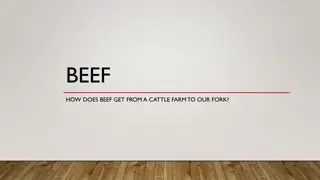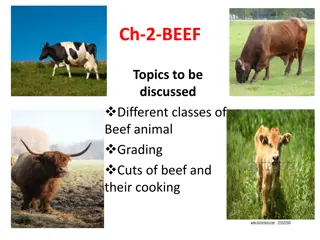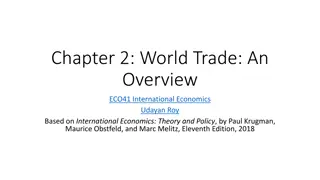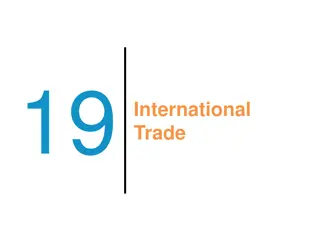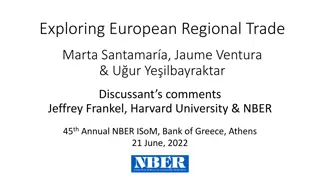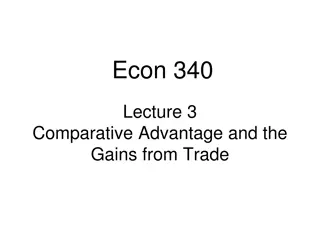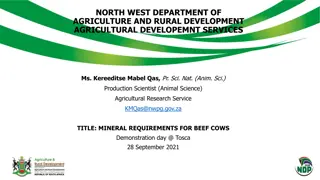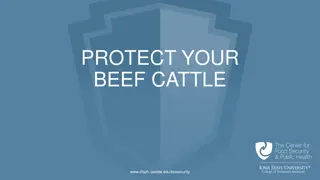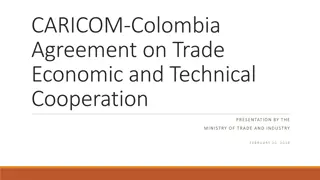Sustainable Trade Solutions for Ngamiland's Beef Industry
The presentation discusses the challenges facing Ngamiland's beef industry due to Foot-and-Mouth Disease (FMD) and explores the potential of adopting a Commodity Based Trade (CBT) approach to revive the economy. By transitioning to CBT, Ngamiland could potentially expand its market access while addressing concerns of FMD transmission. However, implementing this approach comes with practical challenges such as consumer preferences and potential competition from other FMD-endemic countries in the region.
Download Presentation

Please find below an Image/Link to download the presentation.
The content on the website is provided AS IS for your information and personal use only. It may not be sold, licensed, or shared on other websites without obtaining consent from the author. Download presentation by click this link. If you encounter any issues during the download, it is possible that the publisher has removed the file from their server.
E N D
Presentation Transcript
The Case of Ngamiland and Ghanzi Roman Grynberg National Competition Conference Maun, Botswana - 13thMarch 2014
FMD and the Beef Industry in Ngamiland For almost eight years the cattle industry in Ngamiland has been excluded from both domestic and international trade altogether because of the approach taken by DVS to the treatment of FMD it has been based on ever more vaccination and more fencing. The policy has failed because of the increasing interaction between buffalo which are main host for FMD and cattle. The consequence has been the impoverishment of the people of Ngamiland ( Ovaherero have asked to return to Namibia)
Commodity Based Trade Approach Under the OIE rules if you have FMD in your area you can t export but the world s biggest exporter of beef by volume is India and it has endemic FMD? How is it possible to export there is an approach to management of trade which is compatible with the rules of the WTO which allows exports. This called Commodity based trade As long as the animal is itself not infected with FMD there is nothing wrong with beef from an FMD areas as long as it is deboned, lymph nodes removed and Ph Levels controlled. This approach is recognized by the OIE. It is possible to trade beef from the red zone to the green zone but the EU will not accept this.
How do we save Ngamiland from Economic Ruin? Need to move over to commodity based trade system Zimbabwe has abandoned the approach we are using and has moved over to commodity based trade. It is now exporting beef to Angola We need to undertake a risk assessment in Ngamiland to demonstrate to the EU that there is no risk of our exports of beef from the green zone infecting EU cattle if we allow trade from Ngamiland to the rest of Botswana The beef from Ngamiland will not be able to achieve EU prices as long as there is FMD- EU will never accept CBT but we can sell Ngamiland beef to the rest of Botswana and use green zone beef for export to the EU.
Some serious problems with this approach Batswana don t want deboned beef they want low cost brisket on the bone for a brai. If we accept CBT for Ngamiland we will have no scientific basis for not allowing Zimbabwean beef to enter our market. On the horizon is the issue, apparently distant, of Tanzanian and Ethiopian beef which has endemic FMD and if permitted would decrease prices substantially in southern Africa Namibia is already moving in this direction with the Caprivi Strip which has the same issues as Ngamiland Botswana is a signatory to the Phakalane Declaration of SADC which endorses CBT but does nothing to implement. CBT at least allows some market access and decreases the clash b/w wildlife i.e. Tourism and agriculture.
Competition in the Beef Trade Sir Seretse Khama nationalised the abattoir at Lobatseat independence. He was not given to policies of state ownership so why did he do it? The abattoir at the time needed a minimum throughput of some 70,000 head to be economic. There was not sufficient herd and off-take for one abattoir to exist economically. It was a natural monopoly and could not stay in the hands of a private firm such as the owner CDC. BMC was given a legal monopoly on exports on the condition it paid reasonable prices.
Competition in the Beef Trade With the demands of EU compliance there has been no study of what is the minimum efficient scale for an abattoir now but BMC now requires somewhere around 230,000-250,000 head to operate at full capacity. 2010 was its best year for along time at 179,000 head Farmers in Ghanzi want another abattoir. But profitability at BMC rests on greater throughput. More abattoirs simply mean less profits because they divide a limited throughput. But that does not mean that one abattoir will make profits- witness BMC. In Namibia they have an independent abattoir at Vytflei which has not yet made a profit because it does not have sufficient throughput. Namibia has the same problem because of weaner exports to RSA
BMC MANAGEMENT ACCOUNTS FOR FRANCISTOWN AND MAUN , 2008-2012 F'TOWN F'TOWN F'TOWN SALES 166 430 LESS SELLING & DISTRN. EXP (15 125) 2009 2008 2010 2011 2012 MAUN 1 233 F'TOWN 75 526 (3 755) MAUN 18 502 F'TOWN 206 646 (7 719) MAUN 45 441 (1 286) 156 951 (16 193) 266 857 (24 922) - (575) SUB TOTAL - NET SALES ADD/ (LESS) - STOCK MOVEMENT ADD / (LESS)-OTHER INCOME/EXP. TOTAL INCOME TOTAL PRODUCTION EXPENSES Process Materials Packing Materials Miscellaneous Materials Fuel Electricity Purchases Water Purchases Repair and maintenance TOTAL FIXED EXPENSES Salaries Overtime- staff Wages Overtime- Hourly Paid Staff & Labour services Pension & Gratuities Sub total - Staff & Labour Costs 151 305 150 247 (8 614) (3 474) (1 873) (1 979) 140 758 31 076 21 708 193 542 (19 007) - (4 272) (1 203) (1 669) (1 040) (2 668) 241 935 (12 834) 229 527 (14 107) - - (1 180) (205) (1 359) (122) (2 385) (206) (3 565) 1 233 295 (350) 1 178 (637) 71 771 (10 875) 61 269 (12 581) 17 927 2 913 (5 078) 15 762 (6 720) - (247) (396) (465) (816) (127) (4 665) (16 062) (3 154) (77) (1 945) (322) (426) (654) (6 579) 198 927 5 727 2 731 207 385 (25 820) 44 155 (3 208) (5 236) 35 711 (6 523) (1 146) (467) (184) (941) (166) (3 611) (24 432) (4 096) (160) (2 268) (418) (660) (701) (8 303) (564) (494) 427 373 16 93 (8) (3) (8) (5 618) (1 239) (920) (429) (2 601) (1 767) (5 625) (45 803) (15 427) (13 012) (2 931) (4 673) (36 931) (4 840) (1 849) (1 862) (4 343) (4 256) (8 670) (47 378) (14 062) (14 299) (1 301) (3 767) (3 603) (37 781) (998) (305) (96) (48 756) (11 801) (11 361) (2 933) (1 583) (28 421) (39 169) (12 719) (483) (11 690) (886) (3 659) (945) (30 382) (48 048) (12 673) (12 361) (1 115) (2 810) (3 264) (32 750) (21 827) (1 032) (630) (228) (207) (2 149) (285) (528) (4) (301) (750) (458) (48) (587) Other Fixed Expenses SURPLUS BEFORE APPRN & TAX APPROPRIATIONS TO Asset renewal reserve Capital Loan Redemption reserve Development reserve NET INCOME BEFORE TAX TAXATION - CURRENT PERIOD AVAILABLE TO PRODUCER (20 335) 92 877 91 964 92 057 (8 787) 135 366 134 431 134 397 (15 297) 167 373 - - (840) (240) - (94) (109) - 167 024 - - - - - 167 024 (21 288) (19 678) (21 286) - (8 872) 2 885 (20) (9 483) (7 020) (9 596) 134 187 - (16 128) 4 756 (913) (934) (349) (5) (83) - (14) - - (840) (73) - (20) 2 865 (7 025) (5) 134 104 (8 295) 125 809 (83) (1 701) 1 935 (14) (21 286) 4 742 - 2 864 (7 035) PAID TO PRODUCER PAYMENT FOR LIVE STOCK DCP Feed costs DCP cattle costs DCP Commission (91 284) (134 352) (190 409) - (1 761) (42 437) - (24 101) (157 614) (43 128) DCP transport Revenue at slaughter - (2 896) PROFIT / (LOSS) ON DCP 3 143 (3 699) (2 896) NET(DEF)/SUR FOR THE PERIOD 773 45 (20 242) (23 049) (43 272) (31 136) (34 700) (41 192) EXIT PACKAGE BONUS TO STAFF (1 886) - (79) (1 065) (975) (75) 1 056 RETAINED (DEFICIT)/ SURPLUS (1 113) (34) (20 242) (23 049) (44 337) (32 111) (34 776) (40 136)
If we want improved performance from BMC what should we do? BMC absorbs all the surplus generated by European exports- in 2010 the farmer got nothing! BMC lost P727 million b/w 2009- 2012. Farmer needs to be protected by a modified form of Export Parity Pricing because otherwise they become the residual claimant on BMC revenues Need to assure that BMC is managed competitively and efficiently. You have to sack some 500 workers and close at least one abattoir. Privatise its management but only worthwhile if government has the will to run it like a business and keep political considerations out. Allow it to operate as a custom abattoir where many companies can pay for its services and they can export.



